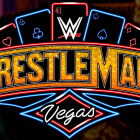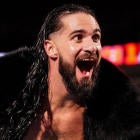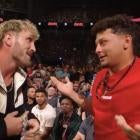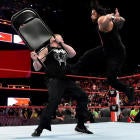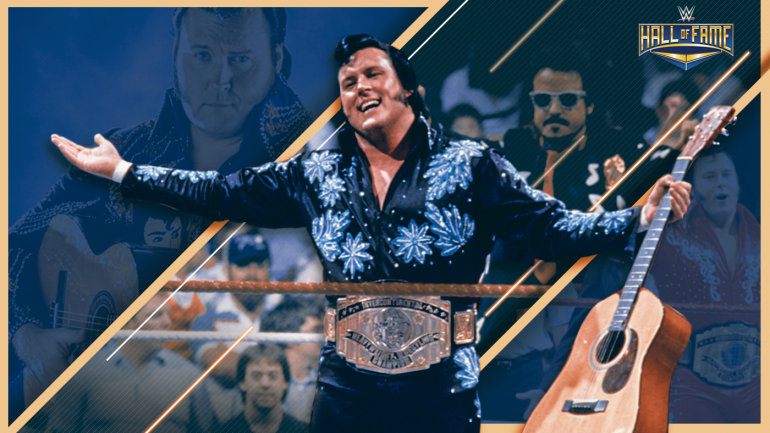
He's cool, he's cocky, he's bad, and on WrestleMania 35 weekend, he'll also become a WWE Hall of Famer. The Honky Tonk Man will join legendary faction D-Generation X on Saturday, April 6 in Brooklyn, New York, as the second member of the 2019 Hall of Fame class.
A master at drawing heat as one of WWE's most iconic heels in the late 1980s, Wayne Farris, better known as The Honky Tonk Man, is famous for a 454-day intercontinental championship reign between 1987-88 that remains the longest in company history. With his long sideburns, slick hair and sequin jumpsuits, The Honky Tonk Man took his gimmick of an Elvis Presley impersonator and gave it evil layers through quick-witted promos and the use of his signature weapon -- the acoustic guitar -- that would inspire many WWE superstars that succeeded him.
Although he has made just a handful of nostalgic appearances on WWE television over the last two decades -- and has not always seen eye to eye with the company along the way, Farris believes the timing was right to come home after initially turning down an offer to be inducted in 2010 due to a prior commitment.
"WWE is the place to be. For me, it's the only place I have ever wanted to be," Farris told CBS Sports' State of Combat podcast. "It's the place that if I'm ready to finish up, that's where I want to be. It's home for me because I have so many fond memories of everything that has been accomplished by WWE and from what I've accomplished myself. It wasn't me alone, it was a huge team effort.
"That is what's amazing and what is so great about being part of the WWE. The door is open to you and it's up to you if you want to walk through it. I look back on everything and for some unknown reason, everything has a meaning. The timing, everything about this year in the 2019 Hall of Fame, everything was lining up perfectly. I never dreamed it was going to happen and would tell people that it's something I don't think about every day of my life. But to be able to be part of this, it's hard to explain."
Subscribe to our WWE podcast -- State of Combat with Brian Campbell -- and listen to our interview with The Honky Tonk Man below.
A first cousin of WWE Hall of Famer Jerry "The King" Lawler, Farris turned pro in 1977 after following Lawler into the wrestling business in Memphis, Tennessee. But it wasn't until Farris was driving on the highway late at night while traveling between different territories in the south that the idea for the character that would ultimately define him came to be.
Frustrated at how stale his everyman persona had become, Farris began listening to the lyrics of the 1956 song "Honky Tonk Man" by Johnny Horton (later a cover hit for Dwight Yoakam in 1986) that was playing in his eight-track player.
"The words that were in this song was about this character that I wanted in my mind," Farris said. "That's where the name came from and that's where I started doing it. I had worked on the character [with Southeastern Championship Wrestling and later at Stampede Wrestling in Calgary] and started to perfect it, but then, WWE polished it up and put the finishing touches on it."
After a brief run as a babyface following his then-WWF debut in September 1986, a much-needed heel turn helped The Honky Tonk Man's career explode as WWE chairman Vince McMahon saw Farris's character as a cocky villain capable of working the main event scene. The Honky Tonk Man captured the intercontinental title from Ricky "The Dragon" Steamboat on a June 13, 1987 episode of "Superstars" and held the title an incredible 64 weeks until losing to The Ultimate Warrior in 31 seconds at SummerSlam in 1988 in a moment that remains to this day the loudest pop he has heard inside an arena.
"I'm not going to sugarcoat it and say that everything came easy and [being champion] was a lovely walk because it was grueling," Farris said. "It was fantastic but it was grueling. We put a lot of time and effort into it to entertain the fans the best we could as WWE wanted us to do it. It was exhilarating. To be out there every night, there was electricity in the air."
Farris said he took a little bit from each of the top heels he worked alongside throughout his nine-year wrestling journey before coming to WWE to create what became The Honky Tonk Man's signature style. He also relentlessly practiced his promos by studying thousands of tag lines he jotted down in a notebook that he still carries in his briefcase today.
"It worked for me to the point where I could project that character out to the viewing audience and get the point across," Farris said. "I could just say these things and make people want to come through the television and choke me.
"I approached every day as if it could be my last hurrah because you are only as famous as your last big match anyway. The intercontinental championship is something that I was shocked and surprised about getting the opportunity to have that. Then I put all my time and effort into being the best I can be because that's just how I want to do stuff. If I can't do it the right way and I can't make the people happy that come to see me than I'm not doing my job."
The Honky Tonk Man was so good at playing the role of a so-called "chicken crap heel" that his greatest feat as might have been how he was able to turn other top bad guys into instant babyfaces simply by attacking them with his guitarr. The two that best come to mind -- Jake "The Snake" Roberts and Randy "Macho Man" Savage -- became the defining feuds of his career.
A 1987 attack of Roberts during his talk show segment "The Snake Pit" led to a brutal guitar shot to the side of Roberts's head (the guitar didn't break) and a memorable grudge match at WrestleMania III that catapulted The Honky Tonk Man to the title level. Six months later on an episode of "Saturday Night's Main Event," The Honky Tonk Man beat down Savage with the help of the Hart Foundation until Hulk Hogan came to the rescue in a moment that launched the MegaPowers angle that would culminate at WrestleMania V.
The Honky Tonk Man, who had a two-year stint beginning in 1989 in the tag team Rhythm & Blues alongside Greg "The Hammer" Valentine, had no shortage of help in getting over thanks to the presence of ringside manager "The Colonel" Jimmy Hart and the late Sherri Martel, who played his mysterious sidekick Peggy Sue.
"I'm so grateful for all the people who have passed through like Jimmy being a big part of it and, of course, the Rhythm and Blues thing," Farris said. "And God bless Sherri Martel. We dressed up and she was Peggy Sue and sometimes we dressed Jimmy Hart up because Sherri would also wrestle [as WWE women's champion], and if she wasn't with us, we would have Jimmy dress up as Peggy Sue and the people didn't know most times."
The Honky Tonk Man has long considered it an honor and tribute to see wrestlers like Jeff Jarrett and Elias carry on his gimmick for breaking guitars, which was a move he first saw Lawler do in Memphis against the Wild Samoans and "Handsome" Jimmy Valiant. But he can only laugh when asked whether he actually knew his way around a fret board and could play a few tunes to pair with the voice he used to sing his "Cool, Cocky, Bad" theme song.
"I have to be like brutally honest: I know nothing about playing the guitar, absolutely nothing," Farris said. "Hillbilly Jim, who could play a million songs and has been playing guitar since before he could walk, tried to teach me how to play a couple of chords, and I just couldn't do it. I've had a couple of really good guitar players come up to me and say, 'You have to know how to play guitar because no one could play that bad.'"
Although he made his name as being a heel, The Honky Tonk Man revels in the babyface reaction he gets from fans today, including a memorable 2013 return on a special "Old School" Raw episode in Buffalo, New York, where he broke a guitar over Heath Slater's head and danced with Brodus Clay and Tensai.
"After all these times of being such a bad guy, I was cheered like I had never been cheered before," Farris said. "After being booed out of all these buildings for so long, they loved me and it was great seeing that. It was exhilarating and fun and I carry that with me.
"Someone asked me not too long ago what I missed most about WWE, and I said, 'Everything.' There is nothing like having that championship and going out and doing radio and TV talking about it. And I was a good bad guy. Some of these kids who are now 40 said they were watching when they were 8 and they thought they could beat me. People wanted me to lose and they didn't care who I lost to."













